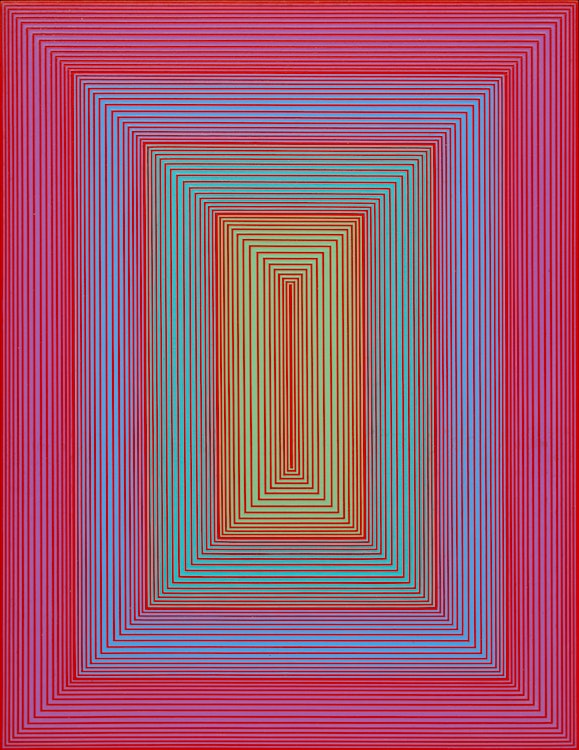The Inner Space by Richard Anuszkiewicz

Richard Anuszkiewicz
The Inner Space
acrylic on board
signed and dated 1970 on the reverse; inventory number 312
21 x 16 ins ( 53.3 x 40.6 cms )
Auction Estimate: $10,000.00 - $15,000.00
Price Realized $16,520.00
Sale date: September 12th 2018
Sidney Janis Gallery, New York
The J L Hudson Gallery, Detroit
Private Collection, Ontario
Cotter, Holland. The New York Times, December 15, 2000, p. E41.
Seitz, William C. The Responsive Eye. Catalogue of an exhibition at The Museum of Modern Art, New York [in collaboration with the City Art Museum of St. Louis, the Contemporary Art Council of the Seattle Art Museum, the Pasadena Art Museum, and the Baltimore Museum of Art]. Museum of Modern Art: New York, 1965.
Painted at the height of his career, in the year following the artist’s major solo exhibition at the Sidney Janis Gallery, New York, in 1969, “The Inner Space” is an investigation of the effects of formal colour and structural phenomena on human perception. With its nested rectangular forms, the painting expresses a preoccupation with optics shared by Anuszkiewicz’s mentor Josef Albers. A master of conceptual abstraction and design theory, the famed colourist’s instruction had a lasting impact on the younger artist’s practice. In his well-known series “Homage to the Square”, Albers experimented with juxtapositions of solid colour; here, however, Anuszkiewicz develops these concepts further, exploring the optical changes that occur when different high-intensity colours—blue, green, magenta, and red—are applied to the same meticulous geometric configurations. As field and foreground dissolve, the dynamic effect of the searing colours is mesmerizing.
Share this item with your friends
Richard Anuszkiewicz
(1930)
Richard Anuszkiewicz is considered a founder and leading proponent of the Optical art movement in America. Born in Erie, Pennsylvania, in 1930, he began his artistic training at the Cleveland Institute of Art, where he excelled in still life and landscape painting from 1948 to 1953. After winning a Pulitzer Traveling Fellowship, Anuszkiewicz pursued a Master of Fine Art degree at the Yale University School of Art and Architecture in New Haven, Connecticut, studying under the renowned artist and educator Josef Albers from 1953 to 1955. Relocating his practice to New York in 1957, Anuszkiewicz quickly achieved critical success, exhibiting in various solo and group shows throughout the city. Following a one-man exhibition at The Contemporaries in New York City in 1960, the Museum of Modern Art, New York, acquired two of his paintings. By the mid-1960s, Anuszkiewicz’s inclusion in the Whitney Museum of American Art Annual Exhibition (1963) and the publication of his painting Mercurian in the Fire on the cover of LIFE International (December 28, 1964) had cemented his status as an Op art icon. By 1965, Anuszkiewicz had firmly established himself as a preeminent contemporary artist with his participation in “The Responsive Eye”, an historic exhibition of Op art, Geometric abstraction, and Hard-edge painting at the Museum of Modern Art. The exhibition featured works by 96 artists, including Victor Vasarely of France and English painter Bridget Riley, Anuskiewicz’s primary international counterparts in the movement.
From the 1970s onward, Anuszkiewicz has mounted over 100 solo shows and participated in almost 300 group exhibitions. He has represented the United States at documenta IV (1968) and the Venice Biennale (1986), and his works are represented in close to 100 public institutions in the United States and abroad, as well as countless private and corporate collections. Anuszkiewicz has executed nearly a dozen large murals and public art commissions and has received various honours, including the Cleveland Arts Prize for Visual Arts in 1977. He was elected into the National Academy of Design in 1992 as an Associate member before gaining full membership in 1994. More recently, the artist’s distinguished career has been recognized with the Lee Krasner Award in 2000 and the “Lorenzo il Magnifico” International Award for Lifetime Achievement at the 2005 Florence Biennale. The artist currently lives and works in Englewood, New Jersey.

